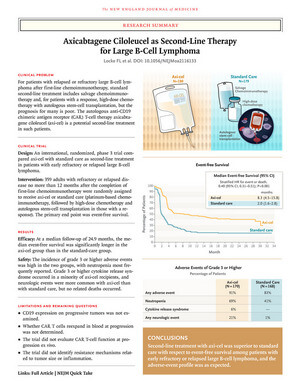Author(s): Frederick L. Locke, M.D., David B. Miklos, M.D., Ph.D., Caron A. Jacobson, M.D., Miguel-Angel Perales, M.D., Marie-José Kersten, M.D., Ph.D., Olalekan O. Oluwole, M.B., B.S., M.D., Armin Ghobadi, M.D., Aaron P. Rapoport, M.D., Joseph McGuirk, D.O., John M. Pagel, M.D., Ph.D., Javier Muñoz, M.D., Umar Farooq, M.D., et al., for All ZUMA-7 Investigators and Contributing Kite Members
Author Affiliations
From the H. Lee Moffitt Cancer Center, Tampa, FL (F.L.L.); Stanford University School of Medicine, Stanford (D.B.M.), and Kite, a Gilead company, Santa Monica (Y.Y., S.F., J.S., M.S., C.T., P.C.) — both in California; Dana–Farber Cancer Institute, Boston (C.A.J.); Memorial Sloan Kettering Cancer Center, New York (M.-A.P.), and the University of Rochester School of Medicine, Rochester (P.M.R.) — both in New York; Amsterdam Medical Center, University of Amsterdam, Cancer Center Amsterdam, Amsterdam (M.-J.K.), University Medical Center Groningen, Groningen (T.M.), and University Medical Center Utrecht, Utrecht (M.C.M.) — all in the Netherlands; Vanderbilt–Ingram Cancer Center (O.O.O.) and Sarah Cannon Research Institute and Tennessee Oncology (I.W.F.) — both in Nashville; Washington University School of Medicine, St. Louis (A.G.); the Marlene and Stewart Greenebaum Cancer Center, University of Maryland School of Medicine, Baltimore (A.P.R.); the University of Kansas Cancer Center, Kansas City (J. McGuirk); the Swedish Cancer Institute, Seattle (J.M.P.); Banner M.D. Anderson Cancer Center, Gilbert, AZ (J. Muñoz); the University of Iowa, Iowa City (U.F.); Bellvitge Institute for Biomedical Research, Universitat de Barcelona, Hematology Department, Institut Català d’Oncologia–Hospitalet, Barcelona (A.S.); University Hospitals Leuven, Leuven, Belgium (P.V.); the Division of Hematology, University of British Columbia and Leukemia–Bone Marrow Transplant Program of British Columbia, Vancouver General Hospital, BC Cancer, Vancouver, Canada (K.W.S.); Peter MacCallum Cancer Centre, Royal Melbourne Hospital and the University of Melbourne, Melbourne, VIC, Australia (M.D.); the University of Chicago Medical Center (P.A.R.) and Northwestern University Feinberg School of Medicine and the Robert H. Lurie Comprehensive Cancer Center of Northwestern University (L.I.G.) — both in Chicago; John Theurer Cancer Center, Hackensack, NJ (L.A.L.); the Centre for Clinical Haematology, University Hospitals Birmingham NHS Foundation Trust, Birmingham, United Kingdom (S.C.); and the University of Texas M.D. Anderson Cancer Center, Houston (J.R.W.).

